Sculptor constellation lies in the southern sky, to the south of Aquarius and Cetus.
It was one of the southern constellations introduced by the French astronomer Nicolas Louis de Lacaille in the 18th century. Lacaille originally named it Apparatus Sculptoris, which means “the sculptor’s studio,” but the name was later shortened to Sculptor.
Sculptor is a rather faint constellation, with no stars brighter than third magnitude. It contains the south galactic pole and is home to several interesting deep sky objects, including the Cartwheel Galaxy, the Sculptor Galaxy (NGC 253), and the Sculptor Dwarf.
Facts, location and map
Sculptor is the 36th constellation in size, occupying an area of 475 square degrees. It is located in the first quadrant of the southern hemisphere (SQ1) and can be seen at latitudes between +50° and -90°.
The neighboring constellations are Aquarius, Cetus, Fornax, Grus, Phoenix and Piscis Austrinus.
The constellation name Sculptor is pronounced /ˈskʌlptər/. In English, the constellation is known as the Sculptor. The genitive form of Sculptor, used in star names, is Sculptoris (pronunciation: /skəlpˈtɒrɪs/). The three-letter abbreviation, adopted by the International Astronomical Union (IAU) in 1922, is Scl.
Sculptor does not have any stars brighter than magnitude 3.00 and contains two stars located within 10 parsecs (32.6 light years) of Earth. The brightest star in the constellation is Alpha Sculptoris, with an apparent magnitude of 4.30. The nearest star is Gliese 1 (spectral class M1.5V), located at a distance of 14.22 light years from Earth.
The constellation contains two formally named stars. The star names approved by the International Astronomical Union (IAU) are Cocibolca (HD 4208) and Uúba (LTT 9779).
Sculptor belongs to the Lacaille family of constellations, along with Antlia, Caelum, Circinus, Fornax, Horologium, Mensa, Microscopium, Norma, Octans, Pictor, Reticulum and Telescopium.
Sculptor has six stars with known exoplanets, HD 4208 (spectral class G7V), HD 4113 (G5V), HD 9578 (G1V), WASP-8 (G6), WASP-29 (K4V) and WASP-45 (K2V). The constellation does not contain any Messier objects and is not associated with any meteor showers.
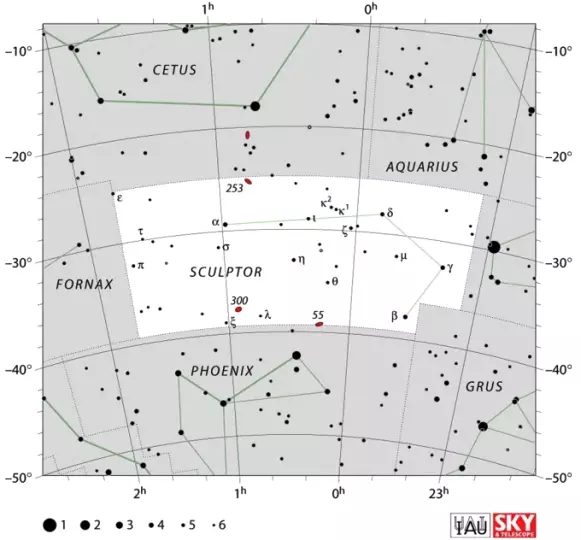
Sculptor constellation map by IAU and Sky&Telescope magazine
Story
Sculptor constellation is not associated with any myths. It is one of the southern constellations introduced by Nicolas Louis de Lacaille in 1751-1752. On his planisphere of 1756, Lacaille named the constellation l’Atelier du Sculpteur, which is French for “the sculptor’s studio.” The constellation was depicted as a carved head lying on a tripod table, next to a sculptor’s mallet and two chisels.
The name was Latinized to Apparatus Sculptoris on Lacaille’s 1763 planisphere and in 1844 the English astronomer John Herschel proposed shortening the name to Sculptor. His suggestion was adopted by Francis Baily in his British Association Catalogue of 1845, and the constellation has been known as Sculptor ever since.
Sculptor stars
α Sculptoris (Alpha Sculptoris)
Alpha Sculptoris is the brightest star in Sculptor constellation. It has an apparent magnitude of 4.30 and is approximately 780 light years distant from Earth. It has the stellar classification of B7 IIIp, which means that it is a blue-white giant star. The star is classified as an SX Arietis type variable, a high-temperature star that exhibits a strong magnetic field and strong H2e I and Si III spectral lines. The star’s brightness varies by 0.01 magnitudes.
Alpha Sculptoris is about 1,700 times more luminous than the Sun and has a surface temperature of 17,379 kelvins. The star has a mass 5.5 times that of the Sun and a radius about 7 times solar.
β Sculptoris (Beta Sculptoris)
Beta Sculptoris is the second brightest star in the constellation. It has an apparent magnitude of 4.38 and is approximately 178 light years distant from the solar system. The star is a blue-white subgiant with the stellar classification of B9.5IV. It is a mercury-manganese star with a strong magnetic field.
Beta Sculptoris is about 82 times more luminous than the Sun. It has a radius double that of the Sun and a mass 3.1 times solar.
γ Sculptoris (Gamma Sculptoris)
Gamma Sculptoris is the third brightest star in Sculptor. It is an orange giant star belonging to the spectral class K1III. It has a visual magnitude of 4.41 and is approximately 179 light years distant from Earth.
δ Sculptoris (Delta Sculptoris)
Delta Sculptoris is a triple star system in Sculptor. It has an apparent magnitude of 4.59 and is approximately 143 light years distant from the Sun.
The system has the stellar classification of A0V. The primary component is a white main sequence dwarf star. The first companion is an 11th magnitude star separated by 4 arc seconds from the primary, and the second companion is a yellow, class G star with an apparent magnitude of 9.4, orbiting the pair at a separation of 74 seconds of arc.
η Sculptoris (Eta Sculptoris)
Eta Sculptoris is a red giant belonging to the spectral class M2/M3III. It has an apparent magnitude of 4.86 and is approximately 548 light years distant from the solar system. It is classified as an irregular variable star. Its brightness varies between magnitudes 4.80 and 4.90.
ζ Sculptoris (Zeta Sculptoris)
Zeta Sculptoris is a binary star in Sculptor. It has an apparent magnitude of 5.04 and is about 510 light years distant from Earth.
The primary component in the system is a blue-white main sequence dwarf and the companion is a 13th magnitude star separated from the primary by 3 arc seconds. The system has the stellar classification of B4V.
ι Sculptoris (Iota Sculptoris)
Iota Sculptoris is an orange giant belonging to the stellar class K0III. It has an apparent magnitude of 5.18 and is approximately 311 light years distant from the solar system.
ε Sculptoris (Epsilon Sculptoris)
Epsilon Sculptoris is another star system in Sculptor. It has an apparent magnitude of 5.29 and is approximately 89.5 light years distant from Earth.
The brightest star in the system is a yellow-white class F subgiant. The first companion is a yellow dwarf star of the spectral type G, with a visual magnitude of 8.6. The two stars complete an orbit around their common centre of mass every 1,200 years. There are two other companions in the system, which are dimmer than the main pair and more distant. One is a 15th magnitude star separated by 15 arc seconds from the main pair and the other is an 11th magnitude star separated by 142 arc seconds.
The Epsilon Sculptoris system has the stellar classification of F2IV+G9V. Around the year 2920, it will have moved to Fornax constellation.
κ Sculptoris (Kappa Sculptoris)
Kappa Sculptoris is a designation shared by two systems, Kappa-1 Sculptoris and Kappa-2 Sculptoris, separated by 0.53° in the sky.
Kappa-1 Sculptoris is a triple star system composed of a binary pair of yellow, class F giant stars with apparent magnitudes of 6.2 and 6.3, and an 18th magnitude companion separated by 70 arc seconds from the main pair. Kappa-1 Sculptoris has a combined apparent magnitude of 5.42 and is approximately 224 light years distant.
Kappa-2 Sculptoris is a binary star with an apparent magnitude of 5.41. It consists of an orange giant and a 21st magnitude companion 46 arc seconds away. The binary system is about 581 light years distant from the Sun.
λ Sculptoris (Lambda Sculptoris)
Lambda Sculptoris is another Bayer designation shared by two separate star systems in Sculptor. Lambda-1 Sculptoris and Lambda-2 Sculptoris are separated by 0.29° in the sky.
Lambda-1 Sculptoris is a binary system with a visual magnitude of 6.05. It is approximately 432 light years distant from Earth. The primary component in the system is a blue-white main sequence dwarf star with an apparent magnitude of 6.7. The dwarf belongs to the spectral class B9.5V. The companion is a white star of the spectral type A9. It has a visual magnitude of 7.0.
Lambda-2 Sculptoris is an orange giant with the stellar classification of K1III. It has an apparent magnitude of 5.90 and is approximately 372 light years distant from Earth.
R Sculptoris
R Sculptoris is a red giant in the final stage of its existence, located approximately 1,500 light years from Earth. It has an apparent magnitude of 5.77.
The star is notable for the unusual spiral structure in the material surrounding it. It is suspected to have an unseen binary companion toward which it is throwing off gas.
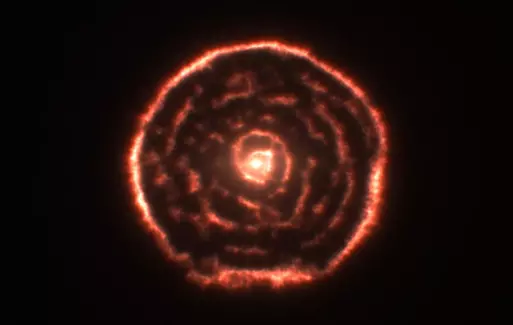
Observations using the Atacama Large Millimeter/submillimeter Array (ALMA) of the European Southern Observatory (ESO) have revealed an unexpected spiral structure in the material around the old star R Sculptoris in the constellation Sculptor. This feature has never been seen before and is probably caused by a hidden companion star orbiting the star. This slice through the new ALMA data reveals the shell around the star, which shows up as the outer circular ring, as well as a very clear spiral structure in the inner material. Image: ALMA (ESO, NAOJ, NRAO)
HD 4208
HD 4208 is a yellow main sequence dwarf with the stellar classification of G5V. It has an apparent magnitude of 7.79 and is approximately 106 light years distant from the Sun. The star is similar to the Sun, but slightly dimmer and cooler. It cannot be seen without binoculars.
A planet was discovered in the star’s orbit in 2001. It has a mass at least 0.6 times that of Jupiter and it completes an orbit around the star every 828 days.
HD 4113
HD 4113 is another yellow dwarf with a planet confirmed in its orbit. The star belongs to the spectral class G5V and has an apparent magnitude of 7.88. It is approximately 144 light years distant from the solar system.
The planet was discovered on October 26, 2007. It has a mass at least 1.56 times that of Jupiter and an orbital period of 526.62 days.
HD 9578
HD 9578 is another yellow main sequence dwarf in Sculptor. It has the stellar classification of G1V. It has an apparent magnitude of 8.201 and is about 187 light years distant from Earth.
A planet was discovered orbiting the star in 2009. The planet has at least 0.62 times Jupiter’s mass and completes an orbit around the star every 494 days.
WASP-8
WASP-8 is another yellow main sequence dwarf with a confirmed planet. The star belongs to the spectral class G6 and has a visual magnitude of 9.9. It is about 160 light years distant from Earth. It has 93 percent of the Sun’s mass and radius, and 79 percent of the Sun’s luminosity.
The planet, WASP-8b, was discovered using the astronomical transit method. It has a mass 2.23 times that of Jupiter and completes an orbit around the star every 8.16 days.
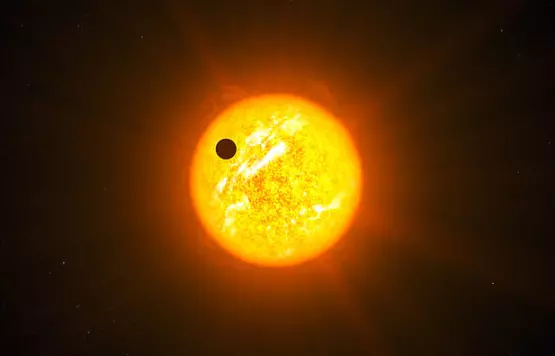
Up to now it was expected that exoplanets would all orbit in more or less the same plane, and that they would move along their orbits in the same direction as the star’s rotation — as they do in our Solar System. However, new results unexpectedly show that many exoplanets actually orbit at a large angle to their star’s spin axis. In the case shown here (WASP 8b) the orbit is completely reversed, or retrograde. Image: ESO, L. Calçada (artist’s impression)
Deep sky objects in Sculptor
Sculptor Group
The Sculptor Group is a group of galaxies located near the south galactic pole in Sculptor constellation. It is a relatively loose group, and one of the closest groups of galaxies to the Local Group. The centre of the Sculptor Group is approximately 12.7 million light years distant from the Milky Way.
The brightest members of the Sculptor Group are the Sculptor Galaxy (NGC 253), the spiral galaxies NGC 247, NGC 7793, the dwarf barred spiral galaxy NGC 625 in Phoenix constellation, and the barred irregular galaxy PGC 6430.
Sculptor Galaxy (Silver Coin, Silver Dollar Galaxy, NGC 253, Caldwell 65)
The Sculptor Galaxy is an intermediate spiral galaxy in Sculptor. It is undergoing a period of intense star formation.
The galaxy has a visual magnitude of 8.0 and is approximately 11.4 million light years distant from the solar system. It is one of the brightest galaxies in the sky and can easily be observed with binoculars.
Along with Andromeda Galaxy in the constellation Andromeda, the Sculptor Galaxy is one of the most easily viewed galaxies in the night sky. It is located near the bright star Beta Ceti in Cetus constellation.
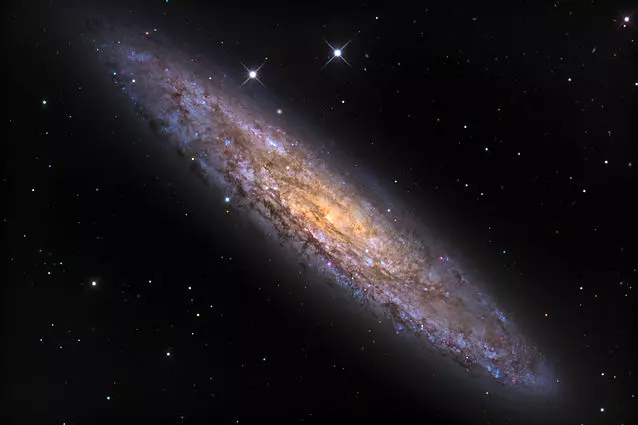
Sculptor Galaxy (NGC 253), image: Adam Block/Mount Lemmon SkyCenter/University of Arizona (CC BY-SA 4.0)
The galaxy was discovered by the German-British astronomer Caroline Herschel in 1783. It is a strong radio source. A supernova, SN 1949E, was observed in the galaxy in 1940.
The Sculptor Galaxy lies at the centre of the Sculptor Group, one of the nearest galaxy groups to the Milky Way. It is the brightest galaxy in the group and, along with companion galaxies NGC 247 and several others to which it is gravitationally bound it forms the core of the group.
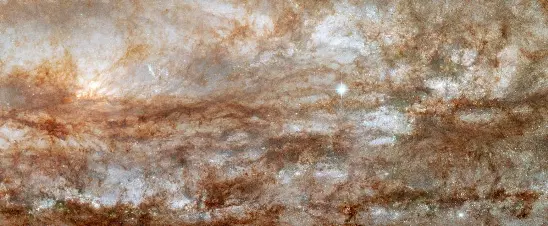
A portion of the spiral galaxy the Sculptor Galaxy (NGC 253) as viewed by the Hubble Space Telescope. NGC 253 is ablaze with the light from thousands of young, blue stars. The spiral galaxy is undergoing intense star formation. The image demonstrates the sharp “eye” of the Advanced Camera, which resolved individual stars. The dark filaments are clouds of dust and gas. NGC 253 is the dominant galaxy in the Sculptor Group of galaxies and it resides about 13 million light-years from Earth. Image: NASA, ESA, J. Dalcanton and B. Williams (University of Washington)
Cartwheel Galaxy
The Cartwheel Galaxy is a lenticular and ring galaxy in Sculptor. It has a visual magnitude of 15.2 and is approximately 500 million light years distant from the solar system. It is about 150,000 light years across, slightly larger than our own galaxy.
The Cartwheel Galaxy was a regular spiral galaxy until it collided with a smaller companion galaxy about 200 million years ago. The smaller galaxy is believed to have passed through the larger one, creating a shock wave that created a starburst region around the central area of the Cartwheel Galaxy. The galaxy is now retaking the form of a spiral galaxy.
The Cartwheel Galaxy was discovered by the Swiss astronomer Fritz Zwicky in 1941.
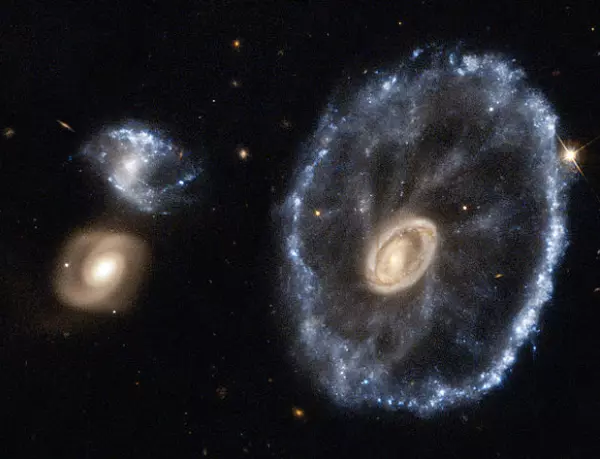
Lying about 500 million light-years away in the constellation of Sculptor, the cartwheel shape of this galaxy is the result of a dramatic galactic collision. A smaller galaxy has passed right through a large disc galaxy and produced shock waves that swept up gas and dust — much like the ripples produced when a stone is dropped into a lake — and sparked regions of intense star formation (appearing blue). The outermost ring of the galaxy, which is 1.5 times the size of our Milky Way, marks the shock wave’s leading edge. This object is one of the most dramatic examples of the small class of ring galaxies. Image: ESA, Hubble & NASA
Sculptor Dwarf
The Sculptor Dwarf, also known as the Sculptor Dwarf Elliptical Galaxy or the Sculptor Dwarf Spheroidal Galaxy, is a dwarf spheroidal galaxy in the Sculptor Group. It is a satellite of our galaxy, the Milky Way. It was discovered by the American astronomer Harlow Shapley in 1937.
The Sculptor Dwarf has an apparent magnitude of 10.1 and is approximately 290,000 light years distant from Earth.
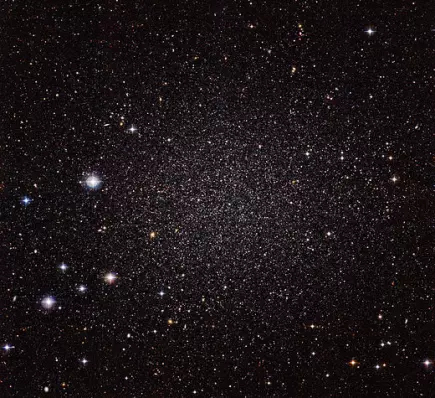
The Sculptor Dwarf Galaxy, pictured in a new image from the Wide Field Imager camera, installed on the 2.2-metre MPG/ESO telescope at ESO’s La Silla Observatory, is a close neighbour of our galaxy, the Milky Way. Despite their proximity, both galaxies have very distinct histories and characters. This galaxy is much smaller, fainter and older than the Milky Way and appears here as a cloud of faint stars filling most of the picture. Many other much more distant galaxies can be seen shining right through the sparse stars of the Sculptor Dwarf. Image: ESO
Sculptor Dwarf Irregular Galaxy
The Sculptor Dwarf Irregular Galaxy is one of the galaxies in the Sculptor Group. It is an irregular galaxy with an apparent magnitude of 15.5, located about 13.4 million light years from Earth.
The galaxy was discovered in 1976. It is a companion to the galaxy NGC 7793, another bright member of the Sculptor Group.
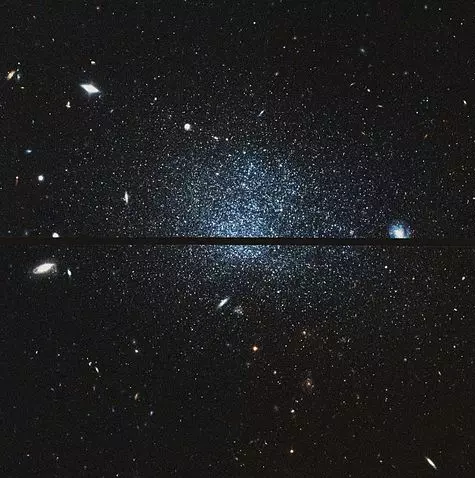
Sculptor Dwarf Irregular Galaxy, image: NASA
Pandora’s Cluster – Abell 2744
Abell 2744, also known as Pandora’s Cluster, is a giant cluster of galaxies in Sculptor. The cluster is the result of at least four smaller galaxy clusters piling up over a period of 350 million years. It was nicknamed Pandora’s Cluster because the collision triggered a number of different and strange phenomena.
Abell 2744 is located at a distance of 3,982 million light years from Earth. Most of its mass is accounted for by dark matter (75%) and hot gas (about 20%), while the galaxies make up less than 5%.
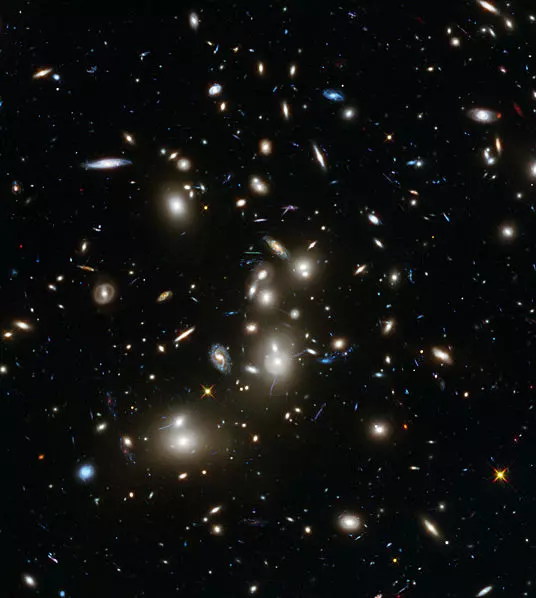
This image of Abell 2744 is the first to come from Hubble’s Frontier Fields observing programme, which is using the magnifying power of enormous galaxy clusters to peer deep into the distant Universe. Abell 2744, nicknamed Pandora’s Cluster, is thought to have a very dramatic history, having formed from a cosmic pile-up of multiple galaxy clusters. Abell 2744 is the first of six targets for an observing programme known as Frontier Fields. This three-year, 840-orbit programme will yield our deepest views of the Universe to date, using the power of Hubble to explore more distant regions of space than could otherwise be seen, by observing gravitational lensing effects around six different galaxy clusters. Image: NASA, ESA, and J. Lotz, M. Mountain, A. Koekemoer, and the HFF Team (STScI), 2014
NGC 55 (Caldwell 72)
NGC 55 is a barred spiral galaxy in Sculptor, seen almost edge-on. Also known as the Whale Galaxy or the Southern Cigar Galaxy, it is not to be confused with the Whale Galaxy (NGC 4631) in Canes Venatici.
NGC 55 has an apparent magnitude of 7.87 and is approximately 7.2 million light years distant from Earth. Like the nearby NGC 300, it is one of the closest galaxies to the Local Group.
The two galaxies lie in the foreground of the Sculptor Group and may be gravitationally bound.
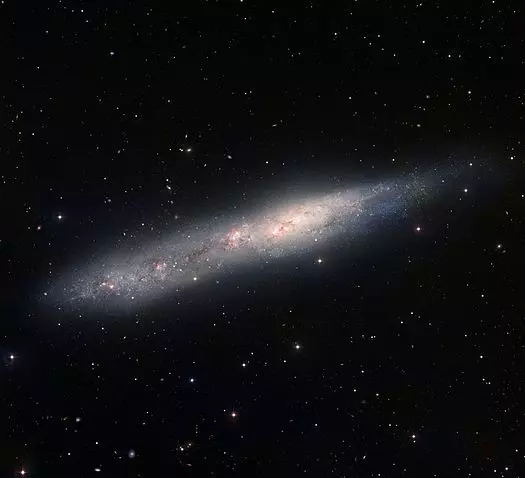
Image of the irregular galaxy NGC 55 obtained with the Wide Field Imager on the 2.2-metre MPG/ESO telescope at ESO La Silla Observatory. Image: ESO
NGC 300 (Caldwell 70)
NGC 300 is one of the brightest spiral galaxies in the direction of the Sculptor Group. It has an apparent magnitude of 9.0 and is about 6.07 million light years distant from the Sun. Like NGC 55, the galaxy does not really belong to the Sculptor Group, but is located in the foreground.
The galaxy has an X-ray source at the core, designated NGC 300 X-1. The source is believed to be a Wolf-Rayet black hole binary system similar to the one in the galaxy IC 10 located in Cassiopeia constellation.
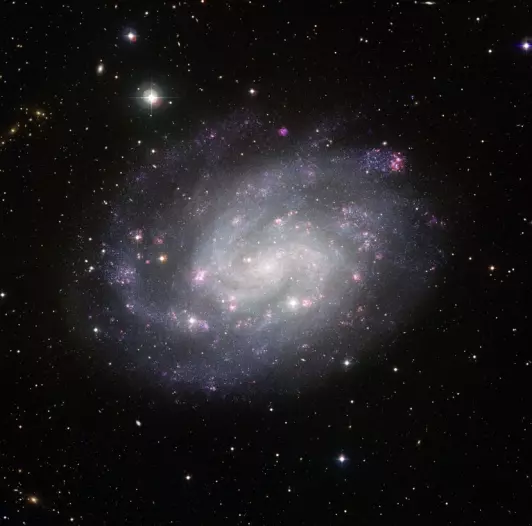
This picture of the spectacular southern spiral galaxy NGC 300 was taken using the Wide Field Imager (WFI) at ESO’s La Silla Observatory in Chile. It was assembled from many individual images through a large set of different filters over many observing nights, spanning several years. The main purpose of this extensive observational campaign was to get an unusually thorough census of the stars in the galaxy, counting both the number and varieties of stars and marking regions, or even individual stars, that warrant deeper and more focussed investigation. But such a rich data collection will also have many other uses for years to come. The images were mostly taken through filters that transmit red, green or blue light. These were supplemented by images through special filters that allow through only the light from ionised hydrogen or oxygen gas and highlight the glowing clouds in the galaxy’s spiral arms. The total exposure time amounted to around 50 hours. Image: ESO
NGC 288
NGC 288 is a globular cluster in Sculptor constellation. It has an apparent magnitude of 9.37 and is approximately 28,700 light years distant from Earth. It lies about 1.8 degrees to the southeast of the Sculptor Galaxy and 37′ to the north-northeast of the South Galactic Pole.
The cluster can be seen in binoculars.
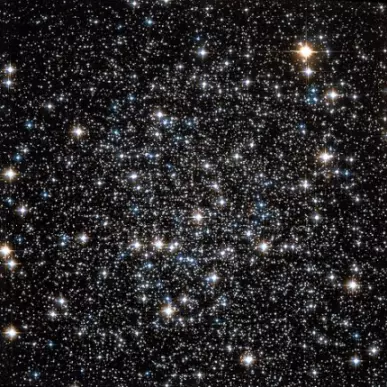
NGC 288, image: NASA
Blanco 1
Blanco 1 is an open cluster located at a distance of 850 light years from Earth. The cluster has an estimated age between 100 and 150 million years. It was named after Victor Manuel Blanco, the Puerto Rican astronomer who discovered it in 1949.
Blanco 1 contains about 300 stars, of which about 170 are brighter than magnitude 12. About half the stars in the cluster are members of binary systems.
NGC 24
NGC 24 is a spiral galaxy with an apparent magnitude of 12.4. It is approximately 22.5 million light years distant from the solar system.
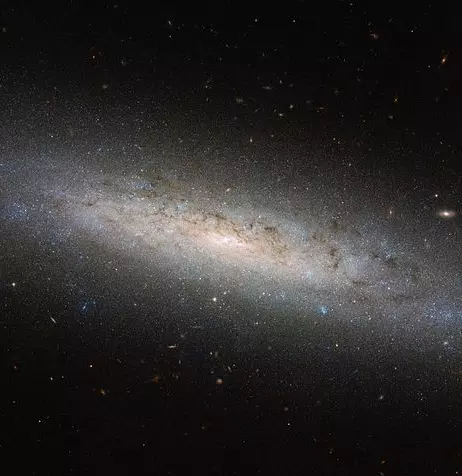
This shining disc of a spiral galaxy sits approximately 25 million light-years away from Earth in the constellation of Sculptor. Named NGC 24, the galaxy was discovered by British astronomer William Herschel in 1785, and measures about 40 000 light-years across. This picture was taken using the NASA/ESA Hubble Space Telescope’s Advanced Camera for Surveys, known as ACS for short. It shows NGC 24 in detail, highlighting the blue bursts (young stars), dark lanes (cosmic dust), and red bubbles (hydrogen gas) of material peppered throughout the galaxy’s spiral arms. Numerous distant galaxies can also been seen hovering around NGC 24’s perimeter. However, there may be more to this picture than first meets the eye. Astronomers suspect that spiral galaxies like NGC 24 and the Milky Way are surrounded by, and contained within, extended haloes of dark matter. Dark matter is a mysterious matter that cannot be seen; instead, it reveals itself via its gravitational interactions with surrounding material. Its existence was originally proposed to explain why the outer parts of galaxies, including our own, rotate unexpectedly fast, but it is thought to also play an essential role in a galaxy’s formation and evolution. Most of NGC 24’s mass — a whopping 80% — is thought to be held within such a dark halo. Image: ESA/Hubble and NASA
NGC 10
NGC 10 is another spiral galaxy in Sculptor. It is approximately 300 million light years distant from Earth.
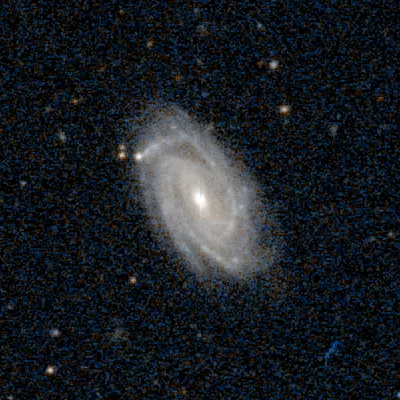
NGC 10, image: ESO
NGC 7
NGC 7 is also a spiral galaxy, possibly barred, and appearing edge-on. It has an apparent magnitude of 13.5 and lies approximately 71.4 million light years from the Sun. The galaxy was discovered by the English astronomer John Herschel in 1834.
NGC 7793
NGC 7793 is another spiral galaxy in Sculptor. It has an apparent magnitude of 10 and is approximately 12.7 million light years distant. It was discovered by the Scottish astronomer James Dunlop in 1826.
The galaxy has a black hole in the outer spiral. A supernova, SN 2008bk, was observed in the galaxy in 2008. It had a visual magnitude of 12.5 and was the second brightest supernova event of the year.
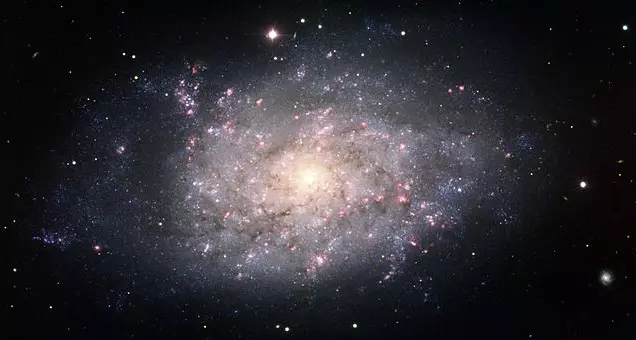
NGC 7793, image: ESO
ESO 540-030
ESO 540-030 is a dwarf galaxy in Sculptor. It is one of the galaxies in the Sculptor Group. It is approximately 11 million light years distant from the Sun.
The galaxy is not an easy object to observe because there are five bright stars located in the foreground and several galaxies in the background.
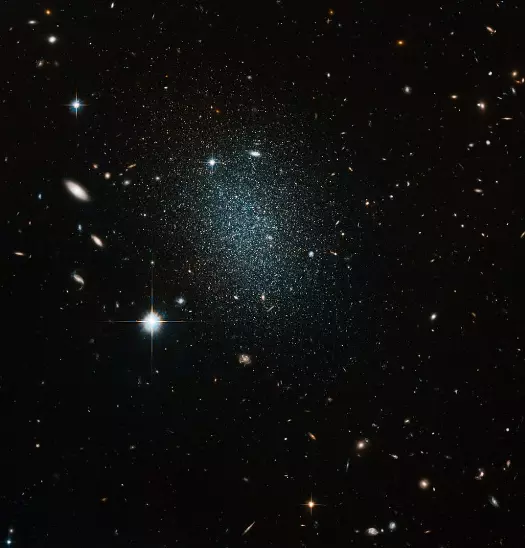
ESO 540-030 is just over 11 million light-years distant, and is part of the Sculptor group of galaxies. This collection is the closest neighbour to our own Local Group of galaxies that includes the Milky Way. Due to its proximity the Sculptor group contains some of the brightest galaxies in the southern skies, although ESO 540-030 is not one of these; dwarf galaxies generally have low surface brightness, which make observations difficult. Hubble has captured an image of galaxy types in the background, with spirals, barred spirals, ellipticals and irregulars on display. Careful examination of this picture should allow examples of each galaxy type to be found. Some galaxies lie directly behind ESO 540-030, increasing the challenge. As well as the galaxies there are also five bright stars, which are much closer to us than the galaxies. The telltale diffraction spikes — four sharp lines of light emanating at 90 degree angles, caused by light diffracting in the telescope — are unmistakable signs of the stars in the picture. Image: ESA, Hubble & NASA
Giant Squid Galaxy – NGC 134
The Giant Squid Galaxy is a barred spiral galaxy approximately 60 million light years away. It has an apparent magnitude of 10.40. The galaxy was discovered by the Scottish astronomer James Dunlop in 1828 and independently found by John Herschel six years later.
NGC 134 has a warped disc and a trail of gas that appears to have been stripped from the top edge of the disc, indicating that the galaxy had an encounter with another galaxy.
On June 20, 2009, a supernova was observed in the galaxy. Designated SN 2009gj, it was classified as a Type IIb supernova. It reached a peak apparent magnitude of 15.9.
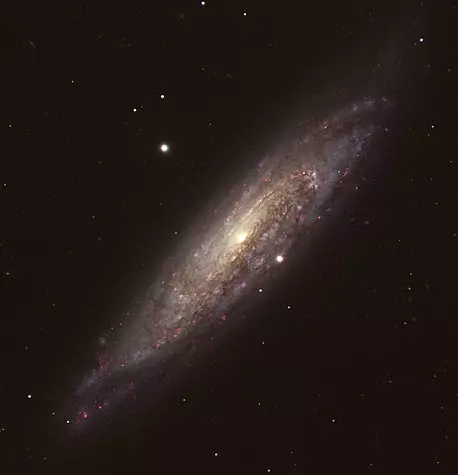
NGC 134 is a barred spiral with its spiral arms loosely wrapped around a bright, bar-shaped central region. The red features lounging along its spiral arms are glowing clouds of hot gas in which stars are forming, so-called HII regions. The galaxy also shows prominent dark lanes of dust across the disc, obscuring part of the galaxy’s starlight. The image is a colour composite based on data obtained in the B, V, R, and H-_ filters with the FORS2 instrument attached to Antu, UT1 of the VLT. Image: ESO: observation by Janez Poto_nik, colour processing by Haennes Heyer and Henri Boffin, with input from Yuri Beletsky.
NGC 613
NGC 613 is a barred spiral galaxy 67.5 million light years away. It has an apparent magnitude of 10 and an apparent size of 5’.2 x 2’.6. The galaxy is an outlying member of the Sculptor Group.
NGC 613 was discovered by William Herschel in 1798 and later independently discovered and catalogued by James Dunlop.
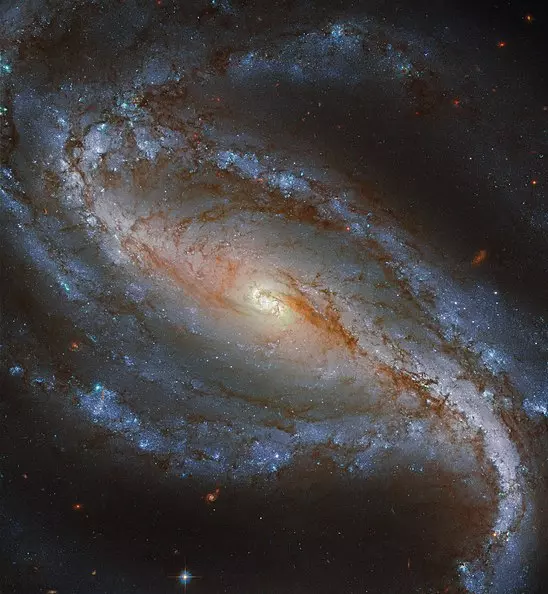
NGC 613, image: ESA/Hubble & NASA, G. Folatelli
Other deep sky objects in Sculptor include the lenticular galaxies NGC 314, NGC 254, NGC 264, NGC 148, and the NGC 526 pair, and the spiral galaxies NGC 115, NGC 131, NGC 150, NGC 289, NGC 174, NGC 334, and NGC 365.